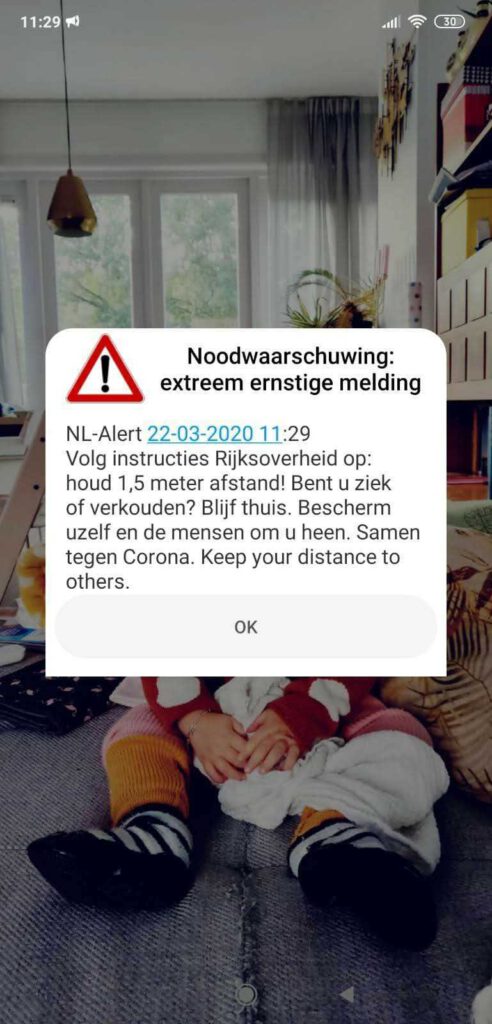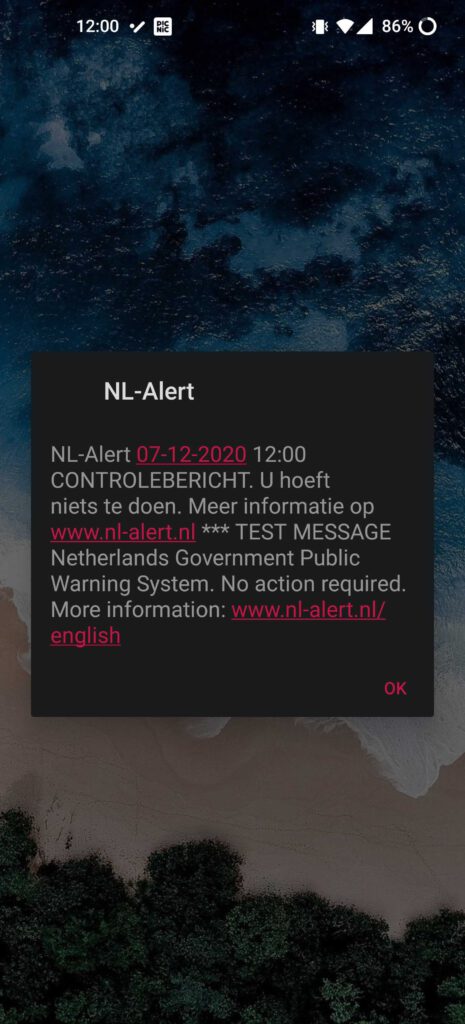So you’re wondering why you’re hearing sirens in the Netherlands on a Monday morning. First of all, don’t worry — we’re not under attack.
Every first Monday of the month (as though we didn’t loathe Mondays already) at 12 PM, the Netherlands tests its public warning sirens.
There are about 4,200 of them throughout the country. Initially used as an air raid alarm, the sirens have also become a warning sign for other disasters over the last couple of decades.
During the test, the siren is heard for one minute and 26 seconds without interruption.
The only instances when you won’t hear it on the first Monday of the month is if that Monday is a national or religious holiday or Remembrance Day.
Unless you’ve actually lived through that one air raid in Rotterdam over 80 years ago, the siren has become something of a nostalgic tradition for most Dutch people.
Is this the best way to test sirens in the Netherlands?
Very understandably, you might be wondering if there’s a better way to test these sirens than, well, blaring them every month and frightening the life out of any unsuspecting foreigner.
In fact, the sirens in the Netherlands go off so often because the government wants people to be aware of what they mean.
You can imagine that if we only heard them once a year, people would get a lot more confused.
It is also important to test them regularly so that if an actual disaster happens, we know that they work.
NL-Alert: an additional warning system
NL-Alert is an additional system that warns and informs residents of the Netherlands about disasters.
The system sends a warning message accompanied by a piercing sound to your phone.
The message tells you what’s going on, what your course of action should be, and where to find more information.
NL-Alert is used in life-threatening and dangerous situations, such as a terrorist attack, major fire, an epidemic or pandemic, or severe weather.
Here’s an example of an NL-Alert from the coronavirus pandemic:

This system also gets regularly tested. Unlike with the sirens, though, you will only receive a test message from NL-Alert twice a year — on the first Monday of June and December at 12 PM. It will look like this:

What if there’s an actual emergency?
In case of an actual emergency, you will hear the siren sound repeatedly.
On top of that, there might also be an accompanying announcement from a PA system. You should follow the instructions of public authorities.
READ MORE | Today in Dutch history: the tragic ‘Watersnoodramp’ flooding of 1953
If you hear the siren sound at a different moment than the first Monday of the month at 12 PM, here’s what you should do:
- Go inside. If you’re on the move, find a building to go into.
- Leave your children at school: schools are prepared for these situations and will know better how to look after the kids than you in this situation.
- Close the doors and windows.
- Try to avoid making phone calls. If possible, go ahead and check online what’s happening.
- Keep an eye on NL-alert.
- Listen to the radio. Here’s more information on how to act in case of emergency
Congratulations, now you’re fully prepared when the sirens in the Netherlands are heard once again!
What did you think the sirens meant before this? Let us know in the comments below.





It is sad to read such an ignorant attempt to joke about the threat of a Soviet/Russian attack. While current Russian political course remains debatable, let me remind that it is mostly Soviet Union to thank for stopping Nazis from taking over old little Europe, including the Netherlands. But thanks for an interesting intro to the Dutch history anyway!
Thanks for the reply and the little compliment. And yes, the Soviets indeed saved everyone’s ass from the Germans back then (if this was such an improvement is still up for debate in Poland and other countries if you totally want to go in to detail, but western Europe lucked out with the yanks so yay for us). But before 1991 when you asked you’re parent why there was even such a thing as the air-raid alarm they would say because of the ‘Soviet’ threat. Justified or not, can’t change that anymore…
National socialism is preferable to communism.
now go to the gulag ivan
I’m a visitor to Holland and heard (for the first time) the sirens today. I must admit it made my heart race for a moment until I got my feet on the ground again and applied some rational thinking!
I lived through the Cuba crisis in the 70’s and recall the times in London when we were told by the UK government that attack was imminent from Russia. Today I prefer to focus on the way in which people from around the world attended the world cup in Moscow and report that the Russian people are lovely and friendly and hospitable.
It’s such a shame that politicians get in the way of unity and sharing good times together 🙂
how have the tables turned – soviet defenders’ descendants proved to be as bad as the enemy they’ve helped to defeat generations ago.
After living in Ukraine for months when russians have invaded, I am really depressed every time I hear those sirens.
“(unless you’ve actually lived through that one airraid in Rotterdam 70 something years ago)”
I suggest the write brushes up on his The Netherlands in World War II history, then he will find out that many more cities in the Netherlands got bombed:
German air raids:
– Luftwaffe, 11 May 1940: Zevenbergen and Zevenbergschen Hoek, 36 dead.
– Luftwaffe, 14 May 1940: Rotterdam, city centre, 650-900 dead.
– Luftwaffe, 14 May 1940: Den Helder, Navy yard 28 dead. Much “colletaral damage”
– Luftwaffe, 17 May 1940: Middelburg, city centre 22 dead.
– Luftwaffe, 19-20 September 1944: Eindhoven , 180 (227) dead.
– Luftwaffe, 2 October 1944: Nijmegen, Waalbridge area, 93 dead. A lot of “collateral damage” the intended target was the bridge of the river Waal.
Allied air raids:
– RAF 24-25 June 1940 Den Helder, Navy Yard 38 dead. Much “collateral damage”
– RAF 3-4 October 1941 Rotterdam, port area 106 (130) dead. A lot of “collateral damage
– RAF 28-29 January 1942 Rotterdam/Schiedam, 71 dead.
– RAF 5-6 October 1942 Geleen, 83 dead. Mistake, the nearby city of Aachen was the intended target
– RAF 6 December 1942 Eindhoven, Philips factory area 138 dead. A lot of “collateral damage
– RAF 19 februay 1943 Den Helder, Navy yard 50 dead. A lot of “collateral damage
– USAAF 31 March 1943 Rotterdam, Tussendijken area Circa 400 dead, intended target nearby Nieuw-Mathenesse port area, but due to a strong, divergent wind a lot of “collateral damage
– RAF 16 April 1943 Haarlem, 85 dead. Intended target Workshops Railway company, but a lot of “collateral damage
– USAAF 17 July 1943 Amsterdam-North 185 (158) dead. Mistake, intended target Fokker Airplane Factories (no hits)
– USAAF 10 Ocktober 1943 Enschede, 151 dead. Mistake, they were looking for a German city as an ‘opportunity target”
– USAAF 22 February 1944 Nijmegen, Maximum 800 dead. Mistake, intended targets the nearby German cities of Cleves and Goch
– USAAF 22 Februariy 1944 Arnhem, Residential area 60 dead. Mistake, intended targets the nearby German cities of Cleves and Goch
– USAAF 22 Februari 1944 Enschede, Industrial area 40 dead. Mistake, intended target the nearby German city of Münster
– RAF 11 April 1944 Den Haag, Huize Kleykamp Circa 60 dead. Target civil registry building
– USAAF 31 may 1944 Roosendaal, railway station area 73 dead. Intended target railway yard, but a lot of “collateral damage
– USAAF 18 August 1944 Maastricht, residential area 91 dead. Mistake, intended target the bridge over river Meuse, but a lot of “collateral damage
– RAF 11 September 1944 Breskens, port areat 199 dead. Intended target port facilities, but a lot of “collateral damage
– USAAF 17 September 1944 Wolfheze, 87 dead. intended target German artillery, but a lot of “collateral damage
– RAF 17 September 1944 Ede 80 dead. Intended target German barracks, but a lot of “collateral damage
– RAF 17 Sseptember 1944 Biggekerke 46 (50) dead. intended target German artillery, but a lot of “collateral damage
– RAF 2 October 1944 Huissen 99 (106) dead. Intended target German troop concentration, but a lot of “collateral damage
– RAF 3 October 1944 Westkapelle, Sea dike Circa 150 dead. intended target the sea dike but a lot of “collateral damage
– USAAF 6 October 1944 Hengelo, Circa 100 dead. Real target railway shunting yard
– USAAF 12 October 1944 Venray at least 50 dead. Tactical targets
– RAF 13 October 1944 Utrecht, railway station area Circa 50 dead. Intended target railway yard but a lot of “collateral damage”
– USAAF 13 October 1944 Venlo at least 40 dead. Intended targets road and railway bridges but a lot of “collateral damage”
– RAF 14 October 1944 Zutphen, area near the IJssel riverl 73 dead. Intended target the bridge over the river IJssel, but a lot of “collateral damage”
– RAF 24 October 1944 Dordrecht, Merwestein park 69 (52) dead. Intended target German HQ, but a lot of “collateral damage”
– RAF 3 November 1944 Venlo Circa 40 dead. Intended targets road and railway bridges but a lot of “collateral damage”
– RAF 26 November 1944 Amsterdam, Euterpestraat More than 50 dead. Intended target Sicherheitsdienst HQ, but a lot of “collateral damage”
– RAF 29 November 1944 Rotterdam, Mathenesser-straat / Heemraadsingel area 64 (45) dead
UnIntended result, intended target Dienststelle (office) of the SD (Sicherheitsdienst),
– RAF 11 December 1944 Leiden, railway stations area 54 dead, Intended target main railway staion, but a lot of “collateral damage”
– RAF 21-22 January1945 Montfort Limburg., 183 dead. Intended target, German supply lines
– RAF 3 march 1945 Den Haag, Bezuidenhout at least 520 dead. Unintended result, intended target V-2 rocket storage in Het Haagsche Bosch.
– USAAF 22 March 1945 Enschede, 65 dead. Intended tactical target, but a lot of “collateral damage”
– USAAF 22 March 1945 Nijverdal, centre 72 dead. Intended tactical target, but a lot of “collateral damage”
– USAAF 24 March 1945 Goor, centre 82 dead. Intended tactical target, but a lot of “collateral damage”
– USAAF 24 March 1945 Haaksbergen, centre 75 (50) dead. Intended tactical target, but a lot of “collateral damage”
Source NIOD
Shit. This is horrifying.
Honestly, I just had my heart jump into my throat. Thank you for the article as my sister left the house and I was alone wondering if I should pack and go since we might be under attack 😃 (joke aside- it is scary…)
Just happened today, while there is war nearby…